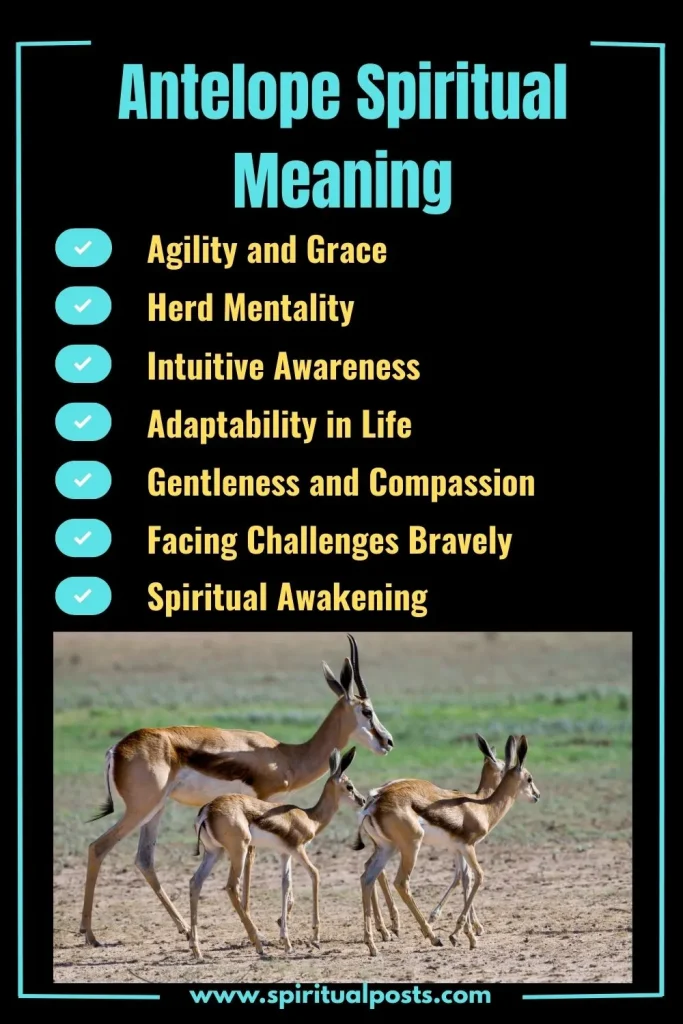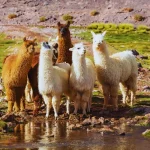Antelope Spiritual Meanings and Symbolism

Antelopes are fast and graceful animals found mostly in Africa and North America. They come in different shapes and sizes. Some well-known types are the gazelle, impala, and pronghorn. What stands out about them is how easily they move through the wild with amazing speed and agility.
Many ancient cultures admired antelopes for their beauty and movement. They saw these animals as symbols of freedom, grace, and spiritual protection. People believed antelopes had a special link to nature and could help guide them through life’s challenges.
Their sharp senses and quick reflexes made them a powerful symbol of awareness. These traits show how being in tune with your surroundings can lead to better choices and deeper wisdom.
Over the years, the antelope has come to represent more than just a wild animal. It now holds spiritual meaning for many, reminding us to stay alert, light-footed, and connected to nature. This animal’s image continues to inspire and teach valuable life lessons.
When we take a closer look at what the antelope stands for, we start to see how its qualities can help guide us through both hard and easy times.

Key Takeaways
- Antelope symbolize agility, grace, and the ability to navigate life’s challenges with fluidity and adaptability.
- Antelope’s herd mentality represents the power of communal support, interdependence, and collaborative wisdom.
- Antelope’s heightened intuitive awareness serves as a reminder to cultivate one’s own intuitive faculties and trust inner guidance.
- Antelope’s adaptability and resilience offer insights for developing flexibility, resourcefulness, and the capacity to embrace change.
What Does It Mean When You See an Antelope ?
Seeing an antelope often carries an important message about focus and flexibility. These animals are always alert and ready to move, which could mean you need to be more attentive to what’s happening around you.
Their graceful leaps and quick turns show how helpful it can be to stay flexible. Life doesn’t always go in a straight line, and the antelope reminds you to adjust when things change suddenly.
An antelope sighting can also point to a need for balance. It might be time to check if you’re doing too much or not enough. These animals move with care and don’t waste energy, which can inspire you to manage your time and energy wisely.
Think about where you may be feeling off-balance. Are you stressed, tired, or trying to do everything at once? The antelope encourages you to move with more calm and purpose.
When this animal crosses your path, it’s often a call to stay alert, stay ready, and find a pace that helps you thrive without burning out.
Antelope Symbolism
The antelope has a rich symbolic meaning that reaches far beyond its appearance. One of its strongest traits is agility, which stands for the ability to handle challenges with ease. This symbol tells us that staying flexible can help us move through problems more smoothly.
Another powerful message is about alertness. The antelope teaches us to pay attention—not just to the outside world, but to our inner thoughts and feelings. Being aware can help you make smarter decisions and avoid trouble before it happens.
The antelope is also known for its gentle and peaceful nature. This reminds you to act with kindness, even when things get hard. It’s okay to be strong and gentle at the same time. That kind of balance can help you stay calm and kind in your relationships.
These animals usually live in groups, which shows the value of community and teamwork. Still, they know how to stay independent too. The message here is to keep a healthy balance between being part of a group and staying true to yourself.
7 Spiritual Meanings of Antelope
As you explore the spiritual significance of antelopes, you’ll discover that their remarkable agility and grace symbolize the nimbleness required to navigate life’s challenges.
Their herd mentality reflects the importance of community and interconnectedness, while their intuitive awareness highlights the value of listening to one’s inner voice.
These majestic creatures also embody the qualities of adaptability, gentleness, and compassion, which can serve as powerful guides on one’s spiritual journey.
1. Agility and Grace
The antelope’s speed and elegance are more than physical traits. They reflect a deeper lesson about staying quick on your feet, both in body and in spirit. When life changes fast, being able to move with it calmly can help you stay strong and balanced.
Their movements show us how to stay steady, even when things around us are uncertain. Whether it’s a new challenge or a surprise event, antelopes teach that it’s possible to stay calm while acting quickly.
They don’t panic when they need to change direction. Instead, they move with confidence. This teaches us that we, too, can adjust our path without fear when things don’t go as planned.
By paying attention to how the antelope moves, we can learn how to handle stress and pressure with lightness and control. Practicing calm thinking and gentle responses can help us find that same ease in our daily lives.
2. Herd Mentality
Antelopes live in groups, and they rely on each other to stay safe. This teaches us how important it is to be part of a supportive community. When we work together, we are stronger and safer than when we face the world alone.
In a herd, each antelope watches out for danger and helps protect the others. This kind of teamwork shows us how being connected to others helps us grow and stay safe.
They move together, share food, and trust one another. These actions are reminders that we all need support from friends, family, and community to live a full and happy life.
The antelope’s strong bond with its group teaches the value of unity. When people look out for one another, everyone benefits. Learning this lesson can help us build healthier and kinder relationships.
3. Intuitive Awareness
The antelope is always alert. It can sense small movements or sounds that others might miss. This is called intuition, and it’s like a quiet voice inside that helps guide and protect.
They don’t wait for danger to show itself. They feel it coming before it even arrives. That sharp awareness helps them survive and keep their group safe.
Their sense of direction and attention to energy helps them stay in tune with their surroundings. This reminds us that paying attention to small things can lead to better decisions in life.
We all have this inner sense too. When we learn to listen to our feelings and observe what’s around us, we can make choices that lead to peace and safety.
4. Adaptability in Life
Antelopes are experts at fitting into their environment, no matter how harsh or wild it might be. Whether it’s dry plains or rocky hills, they find ways to survive and move with ease.
They don’t give up when things get hard. Instead, they use what they know to solve problems and keep moving forward. That’s a powerful message for all of us.
Being able to adjust when plans don’t go our way is a skill that helps us feel less stuck. The antelope shows that there is always a way to keep going, even if the path changes.
When we stay open to new ideas and flexible in our thinking, we grow stronger. Like the antelope, we can bounce back and thrive even when life feels uncertain.
5. Gentleness and Compassion
Even though antelopes are fast and alert, they are also known for their calm and gentle nature. They don’t fight unless they have to, and they care deeply for their young and their group.
Their gentle ways remind us that being kind doesn’t mean being weak. In fact, real strength often shows up through compassion and patience.
They stick close to others and show concern for their group’s safety. This kind of caring spirit teaches us how important it is to look out for each other with love and understanding.
In our own lives, showing kindness—especially during stressful times—can help bring peace and better connections with those around us. The antelope’s heart-centered approach encourages us to act with calm strength.
6. Facing Challenges Bravely
Even though they’re known for running fast, antelopes aren’t afraid to stand up when needed. If danger comes too close, they’ll use their horns and quick moves to protect themselves.
They don’t run away in panic. They wait, watch, and then act at the right moment. This kind of smart bravery teaches us that courage isn’t about being loud—it’s about being prepared and focused.
In life, we all face problems. Whether it’s fear, failure, or hardship, we can choose to face them with the same strength the antelope shows.
By staying calm, using our skills, and believing in ourselves, we too can handle tough times with confidence and power.
7. Spiritual Awakening Symbolism
The antelope isn’t only a symbol of speed or survival. It also points to personal growth and inner change. When an antelope appears in dreams or thoughts, it may mean something inside you is waking up or shifting.
It can be a sign that it’s time to let go of old ideas that no longer help you. The antelope’s ability to move freely reminds us to release what holds us back and live with more freedom.
Its awareness and quick instincts can also represent the rise of your own inner voice and trust in your feelings. When you notice this symbol, it may mean you’re learning to trust yourself more.
Some people connect the antelope to new beginnings and fresh energy. Seeing it may be a sign that you’re ready for a positive transformation in your thinking or your path forward.
Antelope Symbolism in Different Cultures and Contexts
The antelope has long been a creature of fascination in many parts of the world. It shows up in spiritual stories, art, and traditions across continents. With its graceful movement and sharp instincts, it means more than meets the eye.
Different cultures connect the antelope with many powerful ideas. These include strength, speed, awareness, and even spiritual growth. By looking at how various people view this animal, we learn a lot about their beliefs and values.
Each tradition adds its own meaning. From Native American tribes to Celtic legends, and even in biblical texts, the antelope plays an important role. Let’s explore how this amazing animal carries deep symbolic meaning across different cultures.
Native American Culture
In Native American tribes, the antelope holds a place of great respect. Many communities see it as a sacred symbol that connects humans with nature. Its movements, behavior, and role in the wild reflect deeper truths about life.
One of the main symbols tied to the antelope is swiftness and agility. Its quick movements across open land are seen as a sign of strength. This teaches people to stay adaptable and face life’s challenges without fear.
Another important meaning is intuition and awareness. Antelopes are always alert. They notice even the smallest changes around them. This reminds people to be mindful and trust their instincts in difficult times.
The animal also shows us harmony with nature. It lives in balance with the land, using resources wisely and moving with the seasons. This teaches people to care for the Earth and live gently with others.
Lastly, many tribes view the antelope as a symbol of renewal and transformation. As it migrates and changes with the seasons, it becomes a reminder that life is full of cycles—birth, death, and rebirth.
Celtic Culture
In Celtic stories, the antelope is often tied to the divine feminine. Its grace and beauty are seen as signs of powerful female energy. People believed these traits were connected to ancient goddesses.
One such goddess is Eriu, a protector of Ireland. Legends say she could change forms, and the antelope’s elusive nature was a perfect symbol for her. The way the antelope moved silently and swiftly matched her mysterious powers.
The antelope’s horns were also important. To the Celts, they looked like the crescent moon, which connected the animal to cycles of time, fertility, and nature. These links made the antelope sacred in many rituals.
In Celtic culture, animals were not just creatures—they were messengers from the spiritual world. The antelope was seen as a sign of guidance and strength, especially during times of change.
These stories and symbols helped the Celts feel closer to nature. By honoring the antelope, they showed respect for the world around them and the energies that shape life.
Nordic Culture
In the north, where winters were harsh and land was wild, Nordic people saw the antelope differently. They admired its strength and how it seemed to belong to the spirit of the wild.
The antelope’s speed and grace meant a lot. It stood for overcoming tough obstacles. People believed that by following the antelope’s example, they could survive and grow even in the hardest conditions.
Its alertness and sharp senses were also respected. These traits reminded people to stay aware and listen closely to their surroundings. In the wild, this could mean the difference between life and death.
Another symbol was the idea of life, death, and rebirth. The antelope’s horns, which it sheds and regrows, were seen as a symbol of this natural cycle. This gave people hope during hard times.
Lastly, the antelope showed connection to all living things. Its role in nature helped remind people of the balance between humans, animals, and the land. It was more than an animal—it was a guide in a world full of mystery.
African Culture
Across Africa, the antelope means many things. Its meaning depends on the tribe or region. But nearly everywhere, people view it with a deep sense of respect.
The antelope is known for its grace and strength. Its body moves with beauty, but it is also fast and powerful. This mix of traits made it a symbol of balance between toughness and gentleness.
Many African tribes see the antelope as having spiritual power. Some believe it connects the physical world with the spirit world. Its horns often stand for leadership and strength, while its calm nature shows wisdom.
In some areas, certain people are chosen to protect the antelope’s spiritual meaning. They might tell stories, perform dances, or lead rituals that honor this creature.
The antelope also shows up in African myths and folktales, often as a clever or helpful figure. Its role changes from one tale to another, but the deeper meaning always connects back to survival, skill, and respect.
Eastern Culture
In Eastern cultures, the antelope carries spiritual meaning tied to wisdom and peaceful living. It appears in stories, art, and religious ideas, often as a gentle and thoughtful animal.
In Buddhism and Hinduism, the antelope’s ability to move quickly and lightly is seen as a sign of spiritual progress. A person who learns to live like the antelope—graceful, alert, and fast—can move closer to enlightenment.
Many Eastern traditions also link the antelope to fertility and abundance. This isn’t just about having children, but about creating life, wealth, and peace in many forms.
The animal’s gentle strength reflects a balance of masculine and feminine energy. This idea is central to many Eastern philosophies, where true strength comes from being balanced and calm.
Some Eastern shamans see the antelope as a spirit guide. They believe it can move between the seen and unseen worlds, bringing messages, healing, or protection.
Hindu Culture
In Hinduism, the antelope is a special animal with deep ties to gods and spiritual ideas. It often appears in stories, temples, and sacred images.
One of the main links is with Vishnu, one of the most important Hindu gods. He is sometimes shown riding a mythical creature that looks like an antelope. This shows his power to move quickly and watch over all things.
The antelope’s quick movements and focus are also used to teach lessons about spiritual discipline. People on a spiritual path are encouraged to be alert and adaptable, much like the antelope.
Hindus also see the antelope’s group behavior as a sign of unity and connection. It teaches that we are not alone—we are part of a bigger whole.
Through these meanings, the antelope becomes more than an animal. It becomes a model for how to live a thoughtful and spiritual life.
Arts and Literature
Across many cultures, artists and writers have used the image of the antelope to share powerful ideas. It’s often shown as graceful, alert, and free.
In African stories, the antelope shows up as a clever and fast-moving figure. People tell tales where it outsmarts others or escapes danger. These stories help teach lessons about being smart and aware.
Native American art also features the antelope. You might see it on pottery, clothing, or in dance. Each image shows respect for the animal’s role in nature and spirit.
The antelope often stands for qualities like adaptability, intuition, and gentleness. Artists use these symbols to talk about human emotions and challenges in life.
Through stories and artwork, the antelope helps people understand themselves better. It becomes a symbol of survival, connection, and beauty.
Mythology
In myths around the world, the antelope plays many roles. Sometimes it’s a helper, other times a test or a symbol of the divine.
In Native American stories, the antelope acts as a messenger between the human world and the spirit world. It moves fast and silently, guiding people on their spiritual paths.
In Africa, the antelope often stands for feminine energy, fast thinking, and spiritual insight. It appears in dances, songs, and rituals meant to honor nature.
In Greek myths, there’s a magical creature like an antelope called the Ceryneian Hind. Catching it was one of Heracles’ great challenges. This story shows how valuable and rare such creatures were thought to be.
Across Eurasia, the antelope has been linked to sunlight, seasons, and life cycles. Its horns were often seen as symbols of cosmic power and the rhythm of the universe.
Biblical Meanings
In the Bible, antelope-like animals show up in several places. They are used to describe qualities like speed, grace, and strength.
One example is Deuteronomy 14:5, where the antelope is listed among clean animals. This means it was allowed for people to eat, showing it was seen as pure and good.
Verses like Psalm 18:33 and Habakkuk 3:19 talk about God giving people feet like deer, letting them move with ease and strength. This links the animal to freedom and spiritual help.
Proverbs 6:5 warns people to escape danger like a gazelle from a hunter. The antelope becomes a symbol of smart action and awareness.
These verses highlight how the Bible uses the antelope to teach lessons about faith, renewal, and trusting in God during hard times.
Antelope in Dreams
Seeing an antelope in a dream can mean many things. Its appearance often relates to how you’re moving through life.
If the antelope is running, it may show your need for speed and focus. You might be facing changes and need to act quickly. Its energy pushes you to be alert and strong.
If the antelope is calm, it might mean you’re finding balance and peace. You could be connecting more deeply with nature or your true self.
The way the antelope acts in the dream also matters. Is it alone or in a group? Free or chased? These small details help you understand your emotions and choices.
Dreams like this can guide you. They point to your strengths, your fears, and your journey toward growth.
Spirit Animal, Totem, and Power Animal
If the antelope is your spirit animal, it brings lessons of movement and clarity. It teaches you how to stay light on your feet and aware of what’s around you.
As a totem, the antelope stands for vigilance and survival. It helps people remember to be alert and act fast when needed.
As a power animal, the antelope gives energy and focus. It helps you move through life’s changes with purpose and strength.
This animal also helps people connect to the natural world. It reminds you that there’s a rhythm to life and that staying tuned in helps you stay on track.
Final Thoughts
The antelope is more than a wild animal—it’s a powerful symbol across many lands. From grace and alertness to strength and rebirth, its meanings run deep.
In each culture, the antelope helps people understand something bigger. It speaks to our need for balance, connection, and awareness.
By looking at how different people see the antelope, we learn new ways to grow. Whether in stories, dreams, or beliefs, this gentle creature continues to inspire and teach.
You Might Also Like
1) 10 Spiritual Meanings of White Cat and Its Symbolism
2) Spiritual Meanings of Fennec Fox and Its Symbolism
3) The Spiritual Meanings of Xenarthra and Its Symbolism
4) The Spiritual Meanings of Gopher and Symbolism
5) The Spiritual Meanings of Giraffe and Its Symbolism




















